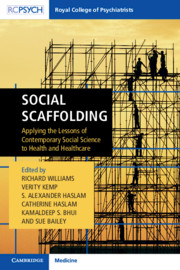Book contents
- Social Scaffolding
- Social Scaffolding
- Copyright page
- Contents
- Contributors
- Foreword
- Note
- Section 1 Schooling
- Chapter 1 Health and Society: Contributions to Improving Healthcare from the Social Sciences
- Chapter 2 Six Features of the Human Condition: The Social Causation and Social Construction of Mental Health
- Chapter 3 Social Sciences and Health: A Framework for Building and Strengthening Social Connectedness
- Chapter 4 The Social Identity Approach to Health
- Chapter 5 The Relevance of Social Science to Improving Health and Healthcare
- Section 2 Scoping
- Section 3 Sourcing
- Section 4 Scaffolding
- Section 5 Sustaining
- Index
- References
Chapter 4 - The Social Identity Approach to Health
from Section 1 - Schooling
Published online by Cambridge University Press: 14 June 2019
- Social Scaffolding
- Social Scaffolding
- Copyright page
- Contents
- Contributors
- Foreword
- Note
- Section 1 Schooling
- Chapter 1 Health and Society: Contributions to Improving Healthcare from the Social Sciences
- Chapter 2 Six Features of the Human Condition: The Social Causation and Social Construction of Mental Health
- Chapter 3 Social Sciences and Health: A Framework for Building and Strengthening Social Connectedness
- Chapter 4 The Social Identity Approach to Health
- Chapter 5 The Relevance of Social Science to Improving Health and Healthcare
- Section 2 Scoping
- Section 3 Sourcing
- Section 4 Scaffolding
- Section 5 Sustaining
- Index
- References
Summary
One of the central ideas that is explored throughout this book is that people’s social lives and the social worlds they inhabit have a critical bearing on their health. At one level this message is uncontroversial. There is, after all, plenty of evidence both that social contact, social connections and a rich social life are good for one’s wellbeing (House et al., 1988) and, that those people who are disadvantaged in this respect as a result, for example, of poverty, prejudice or other forms of social exclusion suffer from relatively poor health outcomes (Wilkinson & Marmot, 2003). In this chapter, though, we present a rather more nuanced analysis, which suggests that particular forms of social interaction have an especially important role to play in these dynamics. They are those forms that are grounded in shared social identity, an internalised sense of shared group membership, and an associated sense that one is part of a bigger ‘us’.
- Type
- Chapter
- Information
- Social ScaffoldingApplying the Lessons of Contemporary Social Science to Health and Healthcare, pp. 31 - 39Publisher: Cambridge University PressPrint publication year: 2019
References
- 7
- Cited by

